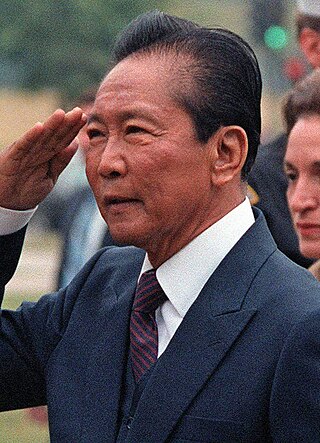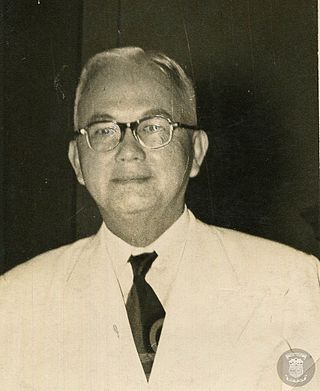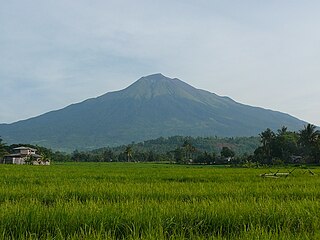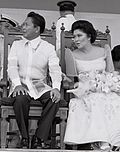
Ferdinand Emmanuel Edralin Marcos Sr. was a Filipino politician, lawyer, dictator, and kleptocrat who was the 10th president of the Philippines from 1965 to 1986. He ruled under martial law from 1972 until 1981 and kept most of his martial law powers until he was deposed in 1986, branding his rule as "constitutional authoritarianism" under his Kilusang Bagong Lipunan. One of the most controversial leaders of the 20th century, Marcos's rule was infamous for its corruption, extravagance, and brutality.

Negros Occidental, officially the Province of Negros Occidental, is a province in the Philippines located in the Western Visayas region. Its capital is the city of Bacolod, of which it is geographically situated and grouped under by the Philippine Statistics Authority, but remains politically independent from the provincial government. It occupies the northwestern half of the large island of Negros, and borders Negros Oriental, which comprises the southeastern half. Known as the "Sugarbowl of the Philippines", Negros Occidental produces more than half the nation's sugar output.

Antonio Yapsutco Fortich was the third bishop of the Diocese of Bacolod. He is noted for being a social activist who fought for social justice in Negros. In 2018, Fortich was recognized by the Human Rights Victims' Claims Board as a Motu Proprio victim of the Martial Law Era.

Escalante, officially the City of Escalante, is a 4th class component city in the province of Negros Occidental, Philippines. According to the 2020 census, it has a population of 96,159 people.

San Carlos, officially the City of San Carlos, is a 2nd class component city in the province of Negros Occidental, Philippines. According to the 2020 census, it has a population of 132,650 people.

Toboso, officially the Municipality of Toboso, is a 3rd class municipality in the province of Negros Occidental, Philippines. According to the 2020 census, it has a population of 43,445 people.

The history of the Philippines, from 1965 to 1986, covers the presidency of Ferdinand Marcos. The Marcos era includes the final years of the Third Republic (1965–1972), the Philippines under martial law (1972–1981), and the majority of the Fourth Republic (1981–1986). By the end of the Marcos dictatorial era, the country was experiencing a debt crisis, extreme poverty, and severe underemployment.

José Certeza Locsín was a Philippine medical doctor and senator.
The Negrenses are the native cultural group of the Philippine provinces of Negros Occidental, Negros Oriental and Siquijor.

Negros is the fourth largest and third most populous island in the Philippines, with a total land area of 13,309 km2 (5,139 sq mi). Negros is one of the many islands of the Visayas, in the central part of the country. The predominant inhabitants of the island region are mainly called Negrenses. As of 2020 census, the total population of Negros is 4,656,945 people.

Maria Rowena Amelia Villena Guanzon, is a Filipina lawyer, public servant, and politician who notably served as Philippine Commission on Elections commissioner from 2015 to 2022 under President Benigno Aquino III and President Rodrigo Duterte. She had been an audit commissioner before taking office at the Philippine Commission on Elections in February 2015.
Roberto Salas Benedicto was a Filipino lawyer, ambassador, diplomat, and banker historically most remembered as a crony of President Ferdinand Marcos. Benedicto owned Philippine Exchange Company, the Philippines Daily Express, Radio Philippines Network (RPN), Banahaw Broadcasting Corporation (BBC) and Intercontinental Broadcasting Corporation (IBC). Benedicto was the Philippines' ambassador to Japan from 1972 to 1978.
During the administration of former Philippine president Ferdinand Marcos (1965–1986) select businesses were favored and patronized by Marcos, receiving financial support, sole patronage, tax exemptions, and control over entire industries rendering these businesses as monopolies. Friends and relatives of Marcos acquired staggering wealth and economic power due to special favors and privileges extended by the administration. While Marcos associates enjoyed government bailout even during the decline of their firms, other businesses suffered high taxes, sanctions, and other unjust treatments that forced them to close up, or to sell their shares. The majority of monopolies linked to Ferdinand Marcos are managed by his close associates, also regarded as cronies by critics. Former First Lady Imelda Marcos insinuated that the Marcoses controlled the majority of the industries in the Philippines. In a 1988 interview, she stated, "We practically own everything in the Philippines—from electricity, telecommunications, airline, banking, beer and tobacco, newspaper publishing, television stations, shipping, oil and mining, hotels and beach resorts, down to coconut milling, small farms, real estate and insurance."
The dictatorship of Philippine President Ferdinand E. Marcos in the 1970s and 1980s is historically remembered for its record of human rights abuses, particularly targeting political opponents, student activists, journalists, religious workers, farmers, and others who fought against the Marcos dictatorship. Based on the documentation of Amnesty International, Task Force Detainees of the Philippines, and similar human rights monitoring entities, historians believe that the Marcos dictatorship was marked by 3,257 known extrajudicial killings, 35,000 documented tortures, 77 'disappeared', and 70,000 incarcerations.
During the presidency of Ferdinand Marcos, Filipino workers in the labor industry experienced the effects of government corruption, crony capitalism, and cheap labor for foreign transnational industries, One of the objectives of Martial Law was to cheapen labor costs, in order to attract transnational corporations to export labor to the Philippines. Marcos signed many presidential decrees beneficial only to his associates, while allowing for the forced relocation of indigenous peoples, decreasing workers' wages, and murders of labor activists. Minimum wage was a fixed PHP8.00 per day. Many workers were unemployed or underemployed. It was also during the Marcos presidency when the practice of contractualization began, enabling managements to avoid giving regular, permanent status to employees after six months of work. Strikes were banned and the government controlled trade unions, leaving workers without effective protection against employers who had unfair labor practices and regulations.

The Sagay massacre occurred when a group of gunmen shot and killed nine sugarcane farmers, including four women and two children, while they were eating dinner in a makeshift tent on a farm in Sagay, Negros Occidental, on October 20, 2018. The farmers were members of the National Federation of Sugar Workers (NFSW), and the massacre may have been motivated by ongoing conflicts over land reform in the Philippines.

The 21-year period of Philippine economic history during Ferdinand Marcos’ regime – from his election in 1965 until he was ousted by the People Power Revolution in 1986 – was a period of significant economic lows.
The Negros killings were a series of targeted assassinations carried out by unidentified gunmen in the provinces of Negros Oriental and Negros Occidental in the Philippines. Some of the victims involved were suspected Communists or sympathizers. Following the killings, Memorandum Order No. 32 was signed by Executive Secretary Salvador Medialdea on November 23, 2018, upon the orders of President Rodrigo Duterte deploying additional troops to the provinces of Negros Oriental, Negros Occidental, Samar, and the Bicol Region to "suppress sporadic acts of violence" allegedly committed by lawless groups and to "prevent such violence from spreading and escalating elsewhere in the country." Even after the memorandum was signed, the incidence of killings continued. According to the Defend Negros Movement, the first recorded extrajudicial killing on Negros Island was Alexander Ceballos on January 20, 2017. The group also alleged that at least 84 persons have been killed since 2017.

Ma. Violeta Marcos, AMP was a Filipino Roman Catholic nun. She was best known as the co-founder and first director of the Augustinian Missionaries of the Philippines, and for her contributions to the resistance in opposition to the martial Law dictatorship of Ferdinand Marcos - first through her diocesan social action involvements in Negros Occidental, and later as part of the human rights organization Task Force Detainees of the Philippines.
The Negros famine took place on Negros island in the Philippines in the mid-1980s, during the waning days of the Marcos dictatorship, and was a key moment in the history of sugar production in the Philippines, as well as the broader political history of the Philippines. Caused by the Marcos administration's efforts to control sugar production through the NASUTRA monopoly held by Marcos crony Roberto Benedicto and by a sudden crash in international sugar prices, it created what popularly came to be known as a "social volcano", with tensions culminating in the Escalante massacre, and with negative effects still felt even after the ouster of Ferdinand Marcos and his cronies during the 1986 People Power Revolution.
















